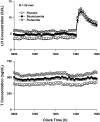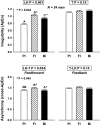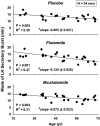Age disrupts androgen receptor-modulated negative feedback in the gonadal axis in healthy men
- PMID: 20682842
- PMCID: PMC2957871
- DOI: 10.1152/ajpendo.00300.2010
Age disrupts androgen receptor-modulated negative feedback in the gonadal axis in healthy men
Abstract
Testosterone (T) exerts negative feedback on the hypothalamo-pituitary (GnRH-LH) unit, but the relative roles of the CNS and pituitary are not established. We postulated that relatively greater LH responses to flutamide (brain-permeant antiandrogen) than bicalutamide (brain-impermeant antiandrogen) should reflect greater feedback via CNS than pituitary/peripheral androgen receptor-dependent pathways. To this end, 24 healthy men ages 20-73 yr, BMI 21-32 kg/m2, participated in a prospective, placebo-controlled, randomized, double-blind crossover study of the effects of antiandrogen control of pulsatile, basal, and entropic (pattern regularity) measurements of LH secretion. Analysis of covariance revealed that flutamide but not bicalutamide 1) increased pulsatile LH secretion (P = 0.003), 2) potentiated the age-related abbreviation of LH secretory bursts (P = 0.025), 3) suppressed incremental GnRH-induced LH release (P = 0.015), and 4) decreased the regularity of GnRH-stimulated LH release (P = 0.012). Furthermore, the effect of flutamide exceeded that of bicalutamide in 1) raising mean LH (P = 0.002) and T (P = 0.017) concentrations, 2) accelerating LH pulse frequency (P = 0.013), 3) amplifying total (basal plus pulsatile) LH (P = 0.002) and T (P < 0.001) secretion, 4) shortening LH secretory bursts (P = 0.032), and 5) reducing LH secretory regularity (P < 0.001). Both flutamide and bicalutamide elevated basal (nonpulsatile) LH secretion (P < 0.001). These data suggest the hypothesis that topographically selective androgen receptor pathways mediate brain-predominant and pituitary-dependent feedback mechanisms in healthy men.
Figures






Similar articles
-
Distinct roles of age and abdominal visceral fat in reducing androgen receptor-dependent negative feedback on LH secretion in healthy men.Andrology. 2014 Jul;2(4):588-95. doi: 10.1111/j.2047-2927.2014.00218.x. Epub 2014 Apr 30. Andrology. 2014. PMID: 24782426 Free PMC article. Clinical Trial.
-
Differential responses of biologically active luteinizing hormone secretion in older versus young men to interruption of androgen negative feedback.J Clin Endocrinol Metab. 1994 Dec;79(6):1763-70. doi: 10.1210/jcem.79.6.7989483. J Clin Endocrinol Metab. 1994. PMID: 7989483
-
The preclinical development of bicalutamide: pharmacodynamics and mechanism of action.Urology. 1996 Jan;47(1A Suppl):13-25; discussion 29-32. doi: 10.1016/s0090-4295(96)80003-3. Urology. 1996. PMID: 8560673
-
The development of Casodex (bicalutamide): preclinical studies.Eur Urol. 1996;29 Suppl 2:83-95. doi: 10.1159/000473846. Eur Urol. 1996. PMID: 8717469 Review.
-
Steroidal regulation of biologically active luteinizing hormone secretion in men and women.Hum Reprod. 1993 Nov;8 Suppl 2:84-96. doi: 10.1093/humrep/8.suppl_2.84. Hum Reprod. 1993. PMID: 8276976 Review.
Cited by
-
Morphological evidence for enhanced kisspeptin and neurokinin B signaling in the infundibular nucleus of the aging man.Endocrinology. 2012 Nov;153(11):5428-39. doi: 10.1210/en.2012-1739. Epub 2012 Sep 25. Endocrinology. 2012. PMID: 23011920 Free PMC article.
-
Network identification of hormonal regulation.PLoS One. 2014 May 22;9(5):e96284. doi: 10.1371/journal.pone.0096284. eCollection 2014. PLoS One. 2014. PMID: 24852517 Free PMC article.
-
Interaction of GPER-1 with the endocrine signaling axis in breast cancer.Front Endocrinol (Lausanne). 2025 Jan 24;16:1494411. doi: 10.3389/fendo.2025.1494411. eCollection 2025. Front Endocrinol (Lausanne). 2025. PMID: 39936103 Free PMC article. Review.
-
Afferent neuronal control of type-I gonadotropin releasing hormone neurons in the human.Front Endocrinol (Lausanne). 2013 Sep 20;4:130. doi: 10.3389/fendo.2013.00130. Front Endocrinol (Lausanne). 2013. PMID: 24062728 Free PMC article. Review.
-
Distinct roles of age and abdominal visceral fat in reducing androgen receptor-dependent negative feedback on LH secretion in healthy men.Andrology. 2014 Jul;2(4):588-95. doi: 10.1111/j.2047-2927.2014.00218.x. Epub 2014 Apr 30. Andrology. 2014. PMID: 24782426 Free PMC article. Clinical Trial.
References
-
- Basaria S, Muller DC, Carducci MA, Egan J, Dobs AS. Hyperglycemia and insulin resistance in men with prostate carcinoma who receive androgen-deprivation therapy. Cancer 106: 581–588, 2006 - PubMed
-
- Belanger A, Giasson M, Couture J, Dupont A, Cusan L, Labrie F. Plasma levels of hydroxy-flutamide in patients with prostatic cancer receiving the combined hormonal therapy: an LHRH agonist and flutamide. Prostate 12: 79–84, 1988 - PubMed
-
- Boxer RS, Kenny AM, Dowsett R, Taxel P. The effect of 6 months of androgen deprivation therapy on muscle and fat mass in older men with localized prostate cancer. Aging Male 8: 207–212, 2005 - PubMed
-
- Braga-Basaria M, Dobs AS, Muller DC, Carducci MA, John M, Egan J, Basaria S. Metabolic syndrome in men with prostate cancer undergoing long-term androgen-deprivation therapy. J Clin Oncol 24: 3979–3983, 2006 - PubMed
-
- Chattopadhyay S, Veldhuis JD, Keenan DM. Probabilistic recovery of pulsatile, secretory and kinetic structure: an alternating discrete and continuous schema. Quarterly Appl Math 66: 401–421, 2008
Publication types
MeSH terms
Substances
Grants and funding
LinkOut - more resources
Full Text Sources
Molecular Biology Databases

